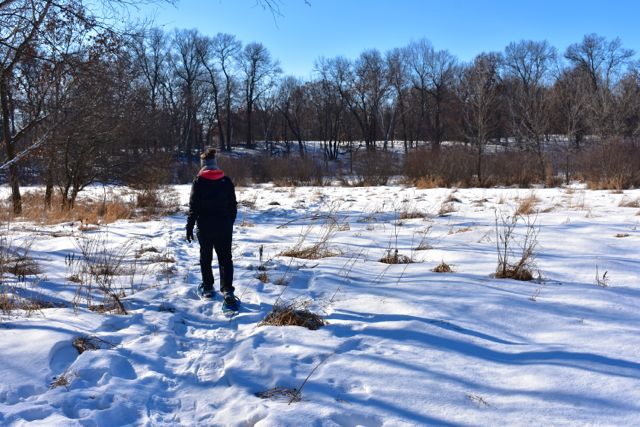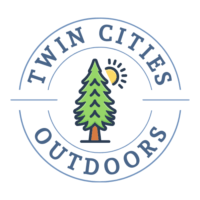
Scientific & Natural Areas are public lands set aside due to their ecological or geological diversity and importance, and are open to foot traffic all year-round. They were new to me, so maybe are new to you, too.
There are many of these areas throughout Minnesota, including several in the Twin Cities metro.
They sound like amazing places to get out and enjoy nature without the crowds!
Scientific & Natural Areas allow hiking, cross country skiing and snowshoeing. While there aren’t any maintained trails, that’s not an issue when it’s snow-covered! In fact, if you love getting away from the bustle of urban life, these Natural Areas may be just the thing.
Another plus with using them during the snowy months—you don’t have to worry about damaging the plant life or dealing with bugs!! Big plus.
There are quite a few restrictions when visiting these areas to keep them as undisturbed as possible. Please read this page on the Minnesota DNR site before visiting.
It lists which ones are best for hiking, which ones allow dogs and guidelines for bringing them along, areas recommending for wildlife and bird watching and much more. It’s a great resource!
These Natural Areas can be found on this map.
Anoka County Scientific & Natural Areas
Blaine Preserve Scientific and Natural Area (Blaine)
Hike, snowshoe, ski. 64 acreas of wet prairies and fens. Great for bird and wildlife watching. Blaine Preserve info here.
Boot Lake Scientific and Natural Area (near Linwood Township)
At 660 acres, the largest of the Twin Cities’ Scientific and Natural Areas. Forest and wetlands with no maintained trails. Borders Carlos Avery Wildlife Management Area. Hiking, skiing and shoeing allowed. Boot Lake info here.
Helen Allison Savanna Scientific and Natural Area (northern Anoka County)
80 acres of classic oak savannah habitat. No maintained trails, but hiking, skiing and shoeing allowed. Helen Allison info here.
Carver County Scientific & Natural Areas
Seminary Fen Scientific and Natural Area (near Shakopee)
73 acres of calcareous fen, one of the rarest types of wetlands. Hiking, skiing, shoeing. An Audobon Important Bird Area. Seminary Fen info here.
Dakota County Scientific & Natural Areas
Hastings Scientific and Natural Area (Hastings)
69 acres of both upland and lowland forest. Audobon Important Bird Area. Visit when the spring woodland flowers are blooming, notably the rare snow trillium. No maintained trails, but hiking, skiing and shoeing allowed. Hastings info here.
Hastings Sand Coulee Scientific and Natural Area (Hastings)
263 acres of dry prairie. No maintained trails, but hiking, skiing and shoeing allowed. Hastings Sand info here.
Pine Bend Bluffs Scientific and Natural Area (near Inver Grove Heights)
256 acres along the Mississippi River, with stunning bluff overlooks, woods and wetlands. Audobon Important Bird Area, including migratory birds. Hiking, skiing, shoeing. Pine Bend info here.
Hennepin County Scientific & Natural Areas
Wolsfeld Woods Scientific and Natural Area (near Maple Plain)
Hike, ski & snowshoe, horses. 220 acres of “big woods” forest. Beautiful in late spring for the flowers and fall for the colors. Wolsfeld even has its own website! And here’s the DNR info page.
Wood-Rill Scientific and Natural Area (near Maple Plain)
141 acres, good for hiking, skiing and snowshoeing. Big woods with trees up to 400 years old. Wood-Rill info here.

Ramsey County Scientific & Natural Areas
Pigs Eye Island Heron Rookery Scientific and Natural Area (St. Paul)
100 acres. Important birding area, one of the largest water bird nesting sites in MN. Closed April 1-July 15. Hiking, shoeing and skiing allowed. Pigs Eye info here.
Scott County Scientific & Natural Areas
Savage Fen Scientific and Natural Area (near Savage)
288 acres of rare wetlands. No maintained trails, but hiking, skiing and shoeing are allowed. Savage Fen info here.
Washington County Scientific & Natural Areas
Crystal Spring Scientific and Natural Area (near Scandia)
38 acres of woodland with steep cliffs and rugged terrain and no maintained trails. That said, hiking, skiing and shoeing is allowed, but use caution. Crystal Spring info here.
Falls Creek Scientific and Natural Area (near Scandia)
138 acres of diverse virgin hardwood and white pine forest. No maintained trails, but hiking, skiing and shoeing allowed. Falls Creek info here.
Grey Cloud Dunes Scientific and Natural Area (Cottage Grove)
237 acres. No maintained trails, but hiking, skiing and shoeing allowed. Known for its sandy terraces, woods and wetlands, along Grey Cloud Slough in the Mississippi River. Grey Cloud Dunes info here.
Lost Valley Prairie Scientific and Natural Area (past Cottage Grove)
320 acres with no maintained trails, but allow hiking, skiing and shoeing. Audobon Important Bird Area. Limestone ridges and tall prairie grasses. Lost Valley info here.
Here’s more…
- Why Nature is So Good for Us
- Winter Hiking in Twin Cities Parks
- Outdoor Recreation Education in the Twin Cities
- New Winter Gear: How Do These Perform? - November 29, 2023
- Paddle North: SUPs, Kayaks and More - November 20, 2023
- 2023 Holiday Gift Guide for Outdoor Lovers - November 10, 2023
